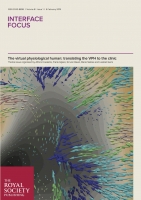On 18 December 2017, Interface Focus published a themed issue ‘The virtual physiological human: translating the VPH to the clinic’ organised by Alfons Hoekstra, Frank Gijsen, Ed van Bavel, Marie Siebes and Liesbet Geris.

The special issue published by the Royal Society focuses on translating the VPH to the clinic, and demonstrates the impact of VPH applications on medicine. The issue is a selection of papers that were presented during the VPH2016 conference in Amsterdam. The theme of the conference was 'translating the VPH to the clinic', and for this reason the issue includes a number of papers that demonstrate the kind of impact VPH applications could have on medical practice in the near future.
In a recent interview released for the launch of the special issue, Alfons Hoekstra (VPH2016 conference chair) explains his vision of the VPH:
"VPH is a big, world-wide community that aims to create validated in-silico models of human health and disease. These models are usually multiscale, and they involve processes at the tissue or organ levels coupled with processes at the cellular levels. For instance models of the heart, where models of individual cells are coupled to mechanical models of heart tissue. The VPH is also about delivering computational and data infrastructure to facilitate VPH modelling, taking into account all the intricacies of dealing with medical data. The long-term goal of the VPH is to create your 'digital twin', a personalised in-silico model of yourself, which should be able to model your physiology or pathologies. Your digital twin that can be used by doctors, or could be used in virtual populations for in-silico trials, or by yourself to manage your health.
In-silico models of physiology or pathology can contribute to medicine in several ways. First, if models can be personalised, they could help doctors to predict for instance the progression of a disease of their patient (e.g. what would be the probability of rupture of a cerebral aneurysm?) or predict the outcome of a treatment. Such predictions could then play a role in decision support scenarios. The in-silico models could also be used on the population level in in-silico clinical trials. They could then predict, for instance, the performance of a new device or a new drug, and as such contribute in designing better and more targeted clinical trials, or help in reducing the use of laboratory animals in first screening of devices. This special issue features papers that cover both applications of the VPH. Finally, the models could also be given to the general public, thus helping us manage our own health and disease..."
Further information on the special issue can be found here
Interested to attend the VPH2018 conference? Don't miss the opportunity to contribute: the abstract submission closes on 15 Feb 2018